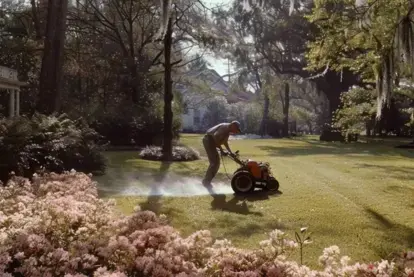
The 13-Step Fall Home Checklist to Prepare Your Home for Winter
Contact COIT for a professional cleaning!
As autumn approaches, it’s time to prepare your home for the colder months. This fall home maintenance checklist will help you take care of your home so you can stay warm, safe, and comfortable throughout winter. At COIT, we’ve been helping homeowners for over 75 years, and we know that a little maintenance now can save you a lot of time, money, and stress later.
We’ve created this fall home maintenance guide to cover all the essential tasks, from cleaning gutters to inspecting windows and beyond. Let’s dive in and get your home ready for winter!
Outdoor Fall Home Maintenance Checklist
1. Clean Gutters and Downspouts
Clean gutters are key for protecting your home from water damage. When leaves, dirt, and debris clog them, rainwater can’t flow away from your home properly. This can cause water to pool around your foundation, leading to cracks or leaks.
What to do: Grab a ladder (or hire a professional) and clean out all debris from your gutters and downspouts. Make sure water can flow freely. While you’re up there, check for any sagging gutters, rust spots, or gaps in the downspouts.
Pro tip: Consider installing gutter guards to make this job easier next year!
2. Inspect and Repair Your Roof
Your roof is your first line of defense against the elements. Before snow and ice arrive, you’ll want to ensure it’s in good shape to avoid costly repairs later.
What to do: Look for missing or damaged shingles, signs of wear, or sagging areas. If you spot any issues, it’s best to call in a professional roofer to make repairs before winter sets in.
Pro tip: Check for any debris (like leaves or branches) that may have accumulated on your roof, especially around chimneys or skylights, and clear it away.
3. Paint and Seal the Exterior
Paint protects your home’s exterior from rain, snow, and moisture. If the paint is peeling or cracking, moisture can seep into the walls and cause damage over time.
What to do: Walk around your home and inspect the paint on your siding, trim, and window frames. Touch up any spots where the paint is peeling or damaged.
Pro tip: Use weather-resistant paint designed to withstand cold temperatures and harsh weather conditions.
4. Lawn and Garden Prep
Your lawn and garden need some attention before winter, too. Taking care of your yard now will give you a head start when spring arrives.
What to do: Rake up fallen leaves, trim back dead plants, and prune your trees and shrubs. If you have any fragile plants, consider covering them to protect them from frost.
Pro tip: After raking leaves, consider composting them for use in your garden next year. You’ll reduce waste and create nutrient-rich compost for your plants.
5. Pest Control
As the weather cools, pests like mice, rats, and insects may try to find shelter in your home. Sealing up any potential entry points now can prevent unwanted guests from moving in.
What to do: Inspect your home’s exterior for cracks, holes, or gaps where pests could get in. Pay extra attention to areas around doors, windows, and the foundation. Use caulk or steel wool to seal any openings.
Pro tip: Don’t forget to check your attic and basement for signs of pests, too.
Indoor Fall Home Maintenance Checklist
6. Inspect Windows and Doors for Drafts
Drafty windows and doors are one of the main reasons for high heating bills in the winter. Sealing them up now can save you a lot of money in the long run.
What to do: On a windy day, walk around your home and check for drafts around windows and doors. You can do this by holding a lit candle near the frames. If the flame flickers, you have a draft. Use weather stripping or caulk to seal up any gaps.
Pro tip: Consider installing storm windows or thermal curtains for extra insulation.
7. Change HVAC Filters and Schedule a Check-up
Your HVAC system works hard to keep your home comfortable in winter, but it needs regular maintenance to perform its best. Fall is the perfect time to replace your furnace filters and schedule a professional HVAC inspection.
What to do: Replace your furnace filter to improve efficiency and air quality. Then, book an appointment with a professional to inspect your furnace and make sure it’s ready for the cold months ahead.
Pro tip: Regularly changing your furnace filters can reduce energy costs and improve your home’s air quality.
8. Check Chimney and Fireplace
If you have a fireplace, fall is the perfect time to get it ready for cozy winter nights. A clean and well-maintained chimney ensures proper airflow and reduces the risk of fire.
What to do: Have your chimney professionally cleaned to remove any soot or creosote buildup. Also, inspect the chimney for any cracks or damage.
Pro tip: If you use your fireplace often, consider installing a chimney cap to prevent debris and animals from getting inside.
9. Reverse Ceiling Fans
Ceiling fans aren’t just for cooling. In the winter, you can reverse their direction to help circulate warm air throughout the room.
What to do: Flip the switch on your ceiling fan to reverse its direction. This will make the blades spin clockwise, pushing warm air down into the room. Run the fan on low speed to avoid creating a draft.
Pro tip: Doing this can help lower your heating bills by making your home feel warmer without turning up the thermostat.
10. Test Smoke and Carbon Monoxide Detectors
As you’re getting your home ready for winter, don’t forget about safety. Smoke and carbon monoxide detectors are essential for keeping your family safe, especially as you start using your furnace or fireplace more often.
What to do: Test all smoke and carbon monoxide detectors in your home. Replace the batteries if necessary and ensure each unit is working properly.
Pro tip: If your detectors are more than 10 years old, consider replacing them entirely.
11. Clean Dryer Vents
Lint buildup in your dryer vent is a fire hazard, and it’s something many homeowners overlook. Fall is a great time to give your dryer vent a thorough cleaning.
What to do: Disconnect your dryer and vacuum out the lint from both the lint trap and the vent hose. You may also want to hire a professional to clean the entire vent system, especially if it’s been a while since the last cleaning.
Pro tip: Make sure the outside vent flap is clear of debris and closes properly.
Safety and Energy-Saving Tips
12. Protect Plumbing from Freezing
Frozen pipes can burst and cause extensive water damage to your home. Taking a few simple steps now can prevent costly repairs later.
What to do: Drain any outdoor faucets and shut off the water to them for the winter. Insulate exposed pipes in your basement, attic, or crawl spaces, especially those near exterior walls.
Pro tip: If you’re going on vacation during the winter, leave your thermostat set to at least 55°F to prevent pipes from freezing.
13. Upgrade Your Insulation
Proper insulation keeps your home warm and can significantly reduce energy costs. If your home is older, it might be worth upgrading your insulation before the cold hits.
What to do: Check the insulation in your attic and basement. If it looks thin or old, consider adding more or upgrading to a more energy-efficient option.
Pro tip: Consider insulating your water heater and hot water pipes to reduce heat loss and save on energy bills.
Don’t Forget: Download Your Fall Home Maintenance Checklist!
We’ve packed a lot of information into this fall home maintenance checklist, but don’t worry—you don’t have to remember it all! Download our printable checklist and keep it handy as you work through your fall home prep. At COIT, we’re here to help you get your home ready for the season.
Whether you need help with deep cleaning, air duct maintenance, or just want to cross a few more things off your to-do list, contact COIT today for professional home services you can trust.



